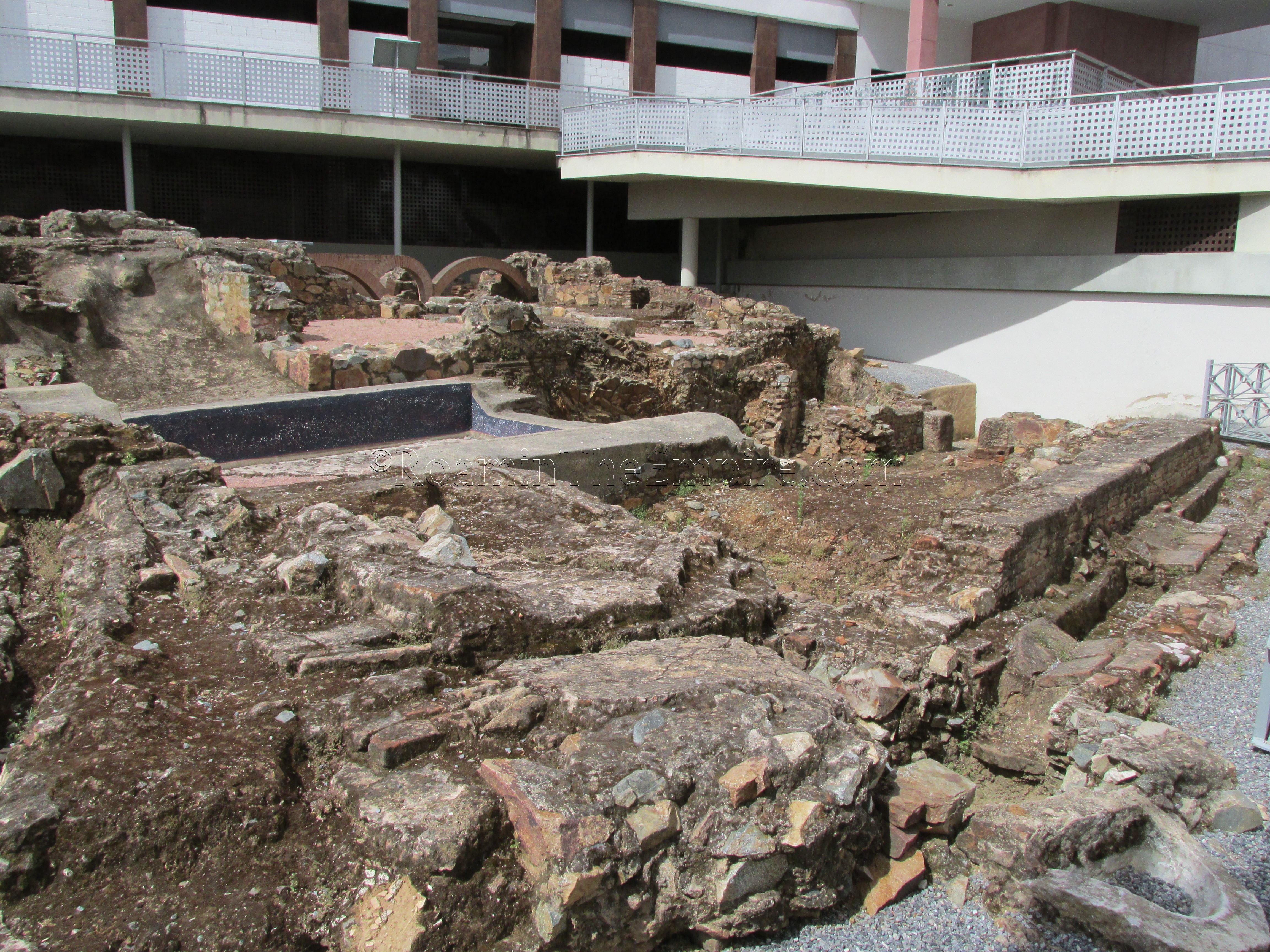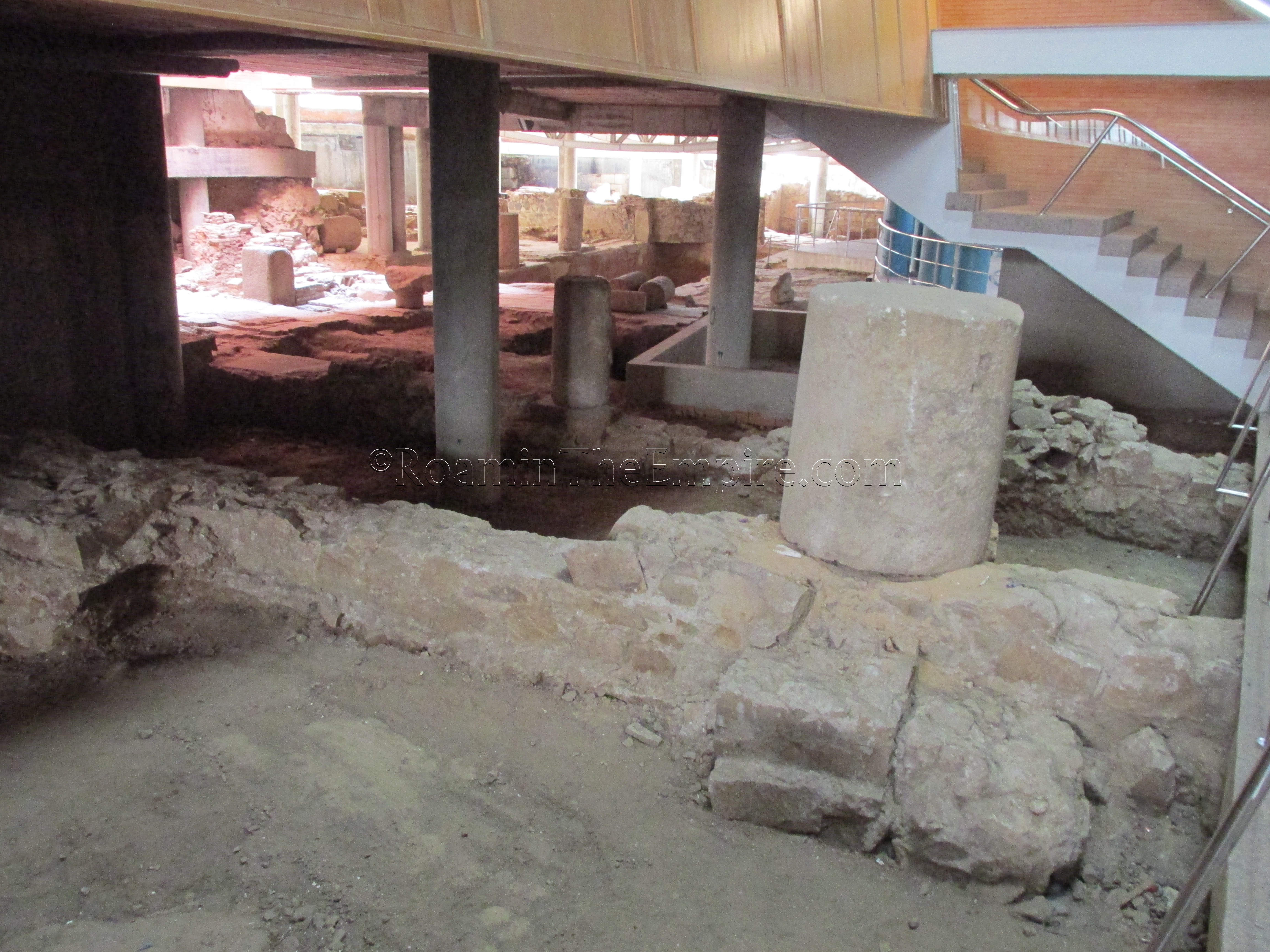
Quick Info:
Snow Baths
Address:
Calle Reyes Huertas 1
06800 Mérida
Hours:
Everyday 10:00-14:00
Admission: Free
Centro Cultural Alcazaba
Address:
Calle John Lennon 5
06800 Mérida
Hours:
Weekdays 08:00-14:00, 17:00-20:00
Admission: Free
Continued From Augusta Emerita Part III
According to a placard at one of the bath complex sites of Augusta Emerita (the Termes de Resti), there have been a total of five public bathing complexes and 15 private baths, associated with private residences, found so far in the city. Of those, a total of 7 of the 21 (three public and four private) are able to actually be visited, with the rest either not being publicly accessible or not currently in a state of excavation. In this post I’ll cover four of those seven, the three public baths and one of the four private baths, as the remaining three private baths have been/will be covered in other posts that discuss the private buildings in which those baths are found.

The first of Augusta Emerita’s remaining bathing complex are the so-called Baths of San Lazaro, which get their name from their proximity to the 16th century San Lazaro Aqueduct bridge. The remains are also very close (about 40 meters) to the remains of the circus. Though the San Lazaro Aqueduct was a later construction, it would have roughly followed the path of the Las Tomas Aqueduct, of which a few pillars are also still standing nearby. Though the baths would have been fed by the Las Tomas Aqueduct, the water would not have come directly from the stretch that passed close by, but rather would have doubled back in a channel from the castellum aquae (located near the Amphitheater House). The bathing complex was public and seems to have been built in the early 2nd century CE. It was in use until the 3rd century CE, but apparently fell into disuse at that time.
What remains on display of the San Lazaro Baths is a roughly 67 x 26 meter, irregularly shaped area to the east of the San Lazaro Aqueduct course and to the northwest of the circus. The northernmost portion of the excavated area is the location of a natatio.

There are a few walls in the interim area between the natatio and the next identifiable feature to the south, the palaestra. The palaestra was bounded by a covered portico, of which some of the granite column bases are still present on the east side. On the west side of the palaestra, some modern wire constructions have been added where the columns of the portico would have been, to illustrate the extent of the palaestra. Some paving stones from the portico are very visible on the west side of the portico, and to a lesser extent on the east side.

The southernmost section, covered by a roof, is occupied by the core rooms of a bathing complex; the apodyterium, caldarium, tepidarium, and frigidarium. The on-site placards don’t do an exceptionally good job of making the plan of this part of the site clear, but the hot rooms are distinguishable by the hypocaust remnants. There was, apparently, at one point a series of wooden figures placed on-site to help illustrate the different rooms and their uses, but they were stolen several years ago. There is only a small pipe fence surrounding the site that really doesn’t do much in the way of keeping out anyone; it’s more there to delineate the bounds of the archaeological site and where visitors are not supposed to go. Because of this, the site unfortunately seems to be a frequent target of both purposeful and ‘accidental’ (people taking cover under the roof when it is raining) vandalism.

A short distance away at Calle Reyes Huertas 1, is perhaps one of the most interesting structures remaining from Augusta Emerita, the so-called Snow Well Baths. The site technically has controlled entry and is locked up, but there is no admission. The site is open between 10:00 and 14:00 every day, but when I arrived within that time frame, it was locked up. After taking a few pictures through the fence and reading the placards in view, though, someone came over from the building across the street to unlock the gate and let me in. So, should this site not be open when it seems it should be, heading across the street to the Centro de Mayores Reyes Huertas (NE corner of the T-intersection in front of the site) might be a good course of action, as someone over there seems to be the custodian for the site.

What makes these baths particularly interesting are that the site seems to have been originally used as a snow storage well before being partially converted to a bathing complex. In the late 1st century BCE or early 1st century CE, a series of stone pits was constructed, three of which remain. There are apparently other associated structures located under surrounding buildings and streets. The pits are surmised to be snow storage for a few reasons; the location of these pits seems to grant them protection from the wind and sunlight, and the stone construction would allow for insulation.

The first two of these pits are interconnected and located near the entrance to the site. The first of these two is partially covered by the walkway and entry platform, but the second is completely visible. A short channel connects these two. The second of the two measures about 5.6 meters in diameter and 2.5 meters in depth, but was likely larger with a significant structure above the level of what remains of the pit. A channel for melt also runs through the bottom of this pit and out into an open area.

The third and largest of the pits is located to the west, and it was this pit and its surroundings that were converted into a public bathing complex sometime in the 1st century CE, while the other two seem to have been left to continue functioning as snow storage. The actual storage pit area would have been covered by a floor, leaving a space between the original bottom of the pit and the new flooring to act as a heated space and praefurnium as the area directly above the pit served as a laconicum. The galleries that lead into this pit are apparently not straight, but rather form a zig-zag path to help prevent drafts when the pit served as snow storage.

The rooms and structures surrounding the pit served were a series of caldaria, and hypocaust pilae remain in a few of these rooms. The multiple hot rooms around the laconicum is a little unusual, but is perhaps a result of the centralized praefurnium. The frigidarium and tepidarium have not been excavated. The baths remained in use until the 4th century CE. During the Visigoth period, the site was used for domestic purposes, and then in the 17th century, the pits were once again used for snow storage. There are a few on-site placards (with English), and they do a pretty good job of explaining the function and layout of the site.

A few blocks to the west, at the intersection of Travesía Rambla Sta. Eulalia and Calle Pontezuelas is the remains of a large public bathing complex referred to as the Termes de Resti. The remains of these baths are displayed in a public square that can be accessed at any time. There are a few catwalks that run along the west side of the remains onto some platforms associated with the building (possibly office space) that have gates that can be closed to limit access around the outside of that building. There are, however some remains tucked back in a courtyard of the building that would not be accessible if these gates were closed (though they are relatively short gates, so one could easily bypass them if so inclined to do so).

About 4000 square meters of the bathing complex have been excavated, but only a fraction of that is on display. The Termes di Resti are, by far, the largest baths found in the city so far. These baths were situated on a hill, parts of which had to be leveled to accommodate the complex, outside of the city walls. They were built in the early 1st century CE and underwent several changes between then and the 4th century CE, when the baths fell into disuse.

Most of what is on display is the heated section of the baths. The laconicum is specifically marked, but not much else is. There are few ancillary rooms that are also marked, but the caldarium and tepidarium are not. The bases of hypocaust pilae in some rooms would seem to indicate their function, but it’s not clearly stated. One smaller room towards the plaza side of the site has some reconstructed wall decoration. A few rooms also have a bit of mosaic remaining and some clearly reconstructed architectural elements.

To the west of the main area that is excavated is a smaller section that is in a sort of courtyard of the building. The room, though not identified for any specific purpose, has apparently had the decorative elements reconstructed to a large degree, per the placard for that section.
A few on-site placards give some information about the baths, but fail to give a good overview of the site. Between those and some of the signs posted on the remains, a bit of the layout of the baths can be discerned, but an overall plan of the site would have been extremely helpful. Instead, visitors are left to try and piece together that incomplete information from disparate sources.

The final set of baths for this post are a bit further south, near the Alcazaba. At Calle John Lennon 5 is the Centro Cultural Alcazaba, a sort of multi-function center with offices and meeting areas and such. It is a public building, so there is no admission, but it is closed on Saturday and Sunday, and is open on weekdays between 8:00-14:00, and again between 17:00-20:00. When entering from the main door at Calle John Lennon, the Roman remains can be found by walking straight back through the entryway, and they stretch all along the backside of the building.

Located here are the remains of a private bathing facility that was uncovered during the construction of this building. When I visited, there still appeared to be a fair bit of conservation work going on with a lot of tools and materials around. There were no placards explaining anything in the site either, which may also be a sign of the incomplete nature of the presentation. In fact, if you don’t know there are remains inside the building, there is really nothing to indicate there is anything there until you go inside and physically see the remains.

There are a few discernable bathing structures evident among the remains. Near the center is a large pool that’s at least a meter deep and several meters long. A lack of documentation, both on site or anywhere else (at least not that I could find) prevent definite identification, but, I would guess that it is a natatio, rather than a frigidarium or caldarium pool. There seems to be a later structure that overhangs the pool. To the left of the pool, and further back on the site, are some remains of brick arches that look to be associated with a heated room or rooms of the baths. Another difficulty in trying to identify structures here is that the access is really limited to one side, so any of the remains further away from this accessible area are not as easy to view. On the far left (west) of the site are the remains of what looks to be a road. Aside from those things, however, it’s difficult to make any other clear declarations as to what survives here.


